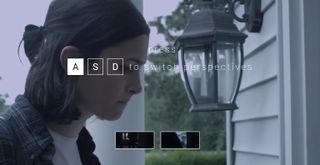Otis is an interactive experience that blurs the line between games and movies
Jump between characters to totally change the course of the film.

Games have been getting progressively more cinematic for years, but even so, projects like Otis are a rare extreme. It’s more of a movie than a game, but there are enough interactive elements that it isn’t easy to classify.
Otis will eventually become a full-fledged crime drama, according to director Casey Stein, while its first episode is more of a prototype. Episode one is a seven-minute short film about a babysitter, a man she’s invited to burgle the house she’s sitting, and the house’s hapless owner. The entire story is filmed from each character’s perspective, so the episode actually contains around 22 minutes of footage. The kicker is that the viewer can swap between perspectives at any time by pressing A, S or D, and all three are constantly available via small picture-in-picture screens.
Alone, each character’s perspective is fairly dull. The first minute or so of the burglar’s view is just him hiding in a car for instance, and the owner is driving to work for much of the middle section. This creates an opportunity to change the channel, as it were, and swap to another character. What’s the babysitter doing while the burglar waits? What’s the burglar doing while the dad drives away? Otis is greater than the sum of its parts, and it gets more interesting the more you swap perspectives.

I started by watching all three perspectives all the way through without swapping at all, doing my best to ignore the smaller screens. The plot is tense so it’s at least watchable, but the story didn’t really coalesce—until I watched Otis a fourth time, deliberately swapping perspectives every few seconds. Suddenly I was curious what other characters were doing and how events lined up. It felt like watching a different film, one somehow longer than seven minutes.
In many ways, Otis makes you a cameraman. Scenes with multiple characters talking in the same room quickly became my favorites because they let me change perspectives in time with dialogue. Cutting out the boring stuff is nice, but manually controlling the flow of a scene like that is incredibly satisfying. It lets you experience the same story in different ways, which seems to have been Otis’s goal.
“You, as a viewer, you’re making decisions that really affect the narrative without feeling like you’re affecting the narrative,” Stein told Engadget. “Because the narrative is actually what you think happened.”
After my fourth time through Otis, I realized how much it reminded me of Her Story, the FMV game from Sam Barlow. It’s an interesting parallel. In many ways, Her Story is the total opposite of Otis. It’s much more of a game, for one. Her Story takes place on an emulated desktop, complete with files to tag and sort through. And where Otis is about experiencing the same story in different ways, Her Story is about piecing together your own story from scattered footage of a series of police interviews. You know exactly what Otis is about, but Her Story invites you to draw your own conclusions.
The biggest gaming news, reviews and hardware deals
Keep up to date with the most important stories and the best deals, as picked by the PC Gamer team.

Even so, the end result is strikingly familiar, to the point that it feels like different means to the same end. Checking a new angle during a heated scene in Otis delivers a remarkably similar thrill to stumbling upon new footage and totally reframing your hypothesis in Her Story. I never got quite the same sense of ‘play’ from Otis, but I was definitely putting in more effort than I would have if I’d just been spoon-fed a pre-cut mix of its three perspectives. It’s a fascinating example of hot and cold media at work, with a hot (leisurely) medium like film being turned into a colder (more demanding) one through, literally, gamification.
Stein says he already has the main plot of Otis worked out: a murder story featuring three people pursuing the same man, but with one trying to save him, one trying to murder him and one trying to arrest him. It’s totally separate from the babysitter prototype and will be considerably longer, but it will follow the same multi-pronged structure. It’s due out in 2018, and after viewing episode one so many times, I’m eager to sit in the director’s chair for a full-length feature.

Austin freelanced for PC Gamer, Eurogamer, IGN, Sports Illustrated, and more while finishing his journalism degree, and has been a full-time writer at PC Gamer's sister publication GamesRadar+ since 2019. They've yet to realize that his position as a staff writer is just a cover-up for his career-spanning Destiny column, and he's kept the ruse going with a focus on news, the occasional feature, and as much Genshin Impact as he can get away with.
Most Popular


